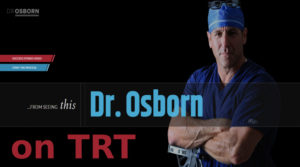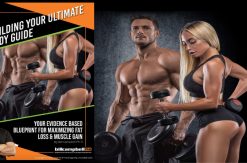INTERVIEW WITH DR. BRETT OSBORN ON TRT by Jay Campbell
Important Testosterone Replacement Therapy Questions Answered by Dr. Brett Osborn and Jay Campbell, in The Definitive Testosterone Replacement Therapy MANual Book.
THE FUTURE IS Now!
CHAPTER 13

Dr. Brett Osborn is a Board—Certified Neurosurgeon with certification in Anti-aging and Regenerative Medicine, a CSCS honorarium from the National Strength and Conditioning Association, and over 30 years of exercise experience.
Dr. Osborn completed his 7-year residency at NYU Medical Center in 2003. He has performed well over 1,500 brain and complex spine operations. Also certified in Anti-Aging and Regenerative Medicine (by the American Academy of Anti-Aging Medicine), Dr. Osborn incorporates non—surgical modalities into his practice, emphasizing proper nutrition, hormonal optimization, and strength training as preventive modalities. Practicing what he preaches, Dr. Osborn is the author of GET SERIOUS A Neurosurgeon? Guide to Optimal Health and Fitness. Dr. Osborn resides in West Palm Beach, FL with his girlfriend Melissa Hankins. He is the father of three beautiful children: Jack, Ellis, and Makenna.
JC: Thank you so much for doing this interview, Dr. Osborn. Let’s get right into it: At this point in time very little consensus exists on 1) what constitutes low testosterone, 2) when testosterone supplementation makes sense, 3) what are the major risks patients face. From your anti-aging physician’s point of view, how would you quickly answer or assess those 3 questions?
BO: Low testosterone is a clinical as opposed to a laboratory diagnosis. It is not simply “low testosterone” on blood testing. What constitutes “low” for one individual may be different than what is considered low for another. So-called “normal” testosterone constitutes levels that fall within a huge range. And herein lies the problem. You may have symptoms of hypogonadism (fatigue, loss of muscle mass, poor libido, etc.) and have T levels within the “normal” range. Likely you would benefit from testosterone replacement therapy regardless (provided other causative etiologies have been ruled out).
Unfortunately, most mainstream physicians fail to recognize that a “normal” T level means relatively little in the context of symptomatic hypogonadism. Again, what be considered a “normal” value (level), may not be normal for you. Discuss T supplementation with your doctor if you suffer from any of the aforementioned symptoms (which typically begin in one’s early 30’s). If he/she is unwilling to consider HRT, well find a new doctor.
The risks of testosterone treatment are minimal despite the media ranting. To date, not a single one of my many HRT patients have developed side effects from treatment. This is due to cautious prescribing habits. Side effects as discussed in the text include alopecia (low percentage of patients), prostatic “flare” (testosterone does not cause prostate cancer; this is a myth), polycythemia, low sperm count, and in the case of injectable T, infection. ‘These risks are far outweighed by the benefits of supplemental testosterone.
JC: It appears many doctors struggle with understanding the correlation between free testosterone and SHBG especially as men age. Do you have a preference between the free testosterone and total testosterone tests?
BO: Both free and total testosterone levels should be assayed. Why? The majority of circulating testosterone is protein bound. Albumin binds testosterone “reversibly.” It has affinity for the molecule but freely releases into the tissues. Sex hormone-binding globulin has a higher affinity for testosterone (and other sex hormones) and binds them “irreversibly.” Once bound, therefore, it is unavailable to the tissues as SHBG does not readily release its grip on the molecule. That said, an SHBG level must be obtained as well. Noting all three levels, your physician will best be able to tailor your therapy. You may have high-normal Total T levels but very low Free T due to high levels of circulating SHBG (essentially gobbling up your manhood). This can be remedied easily with the addition of stinging nettle root extract (228) (and other agents potentially). Obtaining these values in isolation is worthless.
- 228 http://trtrev.com/nettle
JC: In the book, I discuss how in my experience many endos/doctors inaccurately dose injectable testosterone (cypionate/enanthate) allowing for too many peaks and valleys creating a roller coaster effect of T and E. In your practice, how do you avoid this?
BO: I use testosterone cypionate in my practice and dose according to my knowledge of its half-life. That said, I prescribe injections once or twice weekly (at half the dosage). Patient feedback is paramount to optimize one’s response to HRT. If one feels better on twice-weekly dosing, so be it. Levels of both T (total and free) and estradiol are checked frequently to avoid any significant deviations from optimal levels. ‘There tends to be a less aggressive approach in the community, however. I know of many patients who were given prescriptions for T cyp injections once monthly. This carries with it significant risks, namely marked fluctuations in testosterone and estradiol levels in addition to dramatically stressing (and suppressing) the HPTA.
JC: Let’s talk about TRT and cardiovascular risk. How flawed are the JAMA and TOM studies?
BO: Great question. And very timely. Simply put, the studies are flawed. There were several major flaws in both:
- The men were not properly monitored and the dosages of T, therefore, were not restorative (to levels offering previously demonstrated cardio-protection). The men enrolled in this study only boosted their mean total T to 332 ng/dL. This is low in the context of cardio—protecfion. See previous studies that such levels are associated with an increased risk of MI compared with levels above 500-550 ng/dL (229/230).
- Estrogen levels were not routinely assayed. Likely many of the subjects aromatized T (testosterone) to E2 (estrogen) excessively, having not been placed on aromatase inhibitors (or similar medications). Excess circulating estrogen predisposes individuals to thrombotic events. Bottom line, and likely for a variety of reasons, testosterone in physiologic doses (at optimal levels) is cardioprotective. How could the resultant increased vitality (and tendency to exercise which itself confers protection from cardiovascular disease), muscle mass, and libido be associated with an elevated risk of a heart attack? Aren’t these entities associated with youth? That said, adolescents exhibit very high levels of T on formal testing. When was the last time you heard of a 16—year—old male dying of a heart attack? Hmm, never.
- 229 Ohlsson C, Barrett-Connor E, Bhasin S, et 3.1. High serum testosterone is associated with reduced risk of cardiovascular events in men
- 230 The MrOS (Osteoporotic Fractures in Men) study in Sweden. JAm Coll Cardiol. 2011 Oct 11;58(16): 1674-81
JC: Is it therapeutic phlebotomy treatment for polycythemia? How many times a year should a man have his RBCs and hematocrit measured in his blood work?
BO: Many of my patients are routinely phlebotomized. I tolerate hematocrit levels of 50. Anything above warrants concern. I tend to be aggressive about phlebotomy to avoid any potential issues due to “sludging.” That said, patients undergo laboratory testing at 3—month intervals initially. After optimizing their hormone levels, I will typically see patients (and obtain labs) every 6 months. In the interim, they are being phlebotomized per schedule (which ultimately depends upon their response to the prescribed blood draws: a STAT hematocrit is obtained prior to every phlebotomy session).
JC: Do you believe patients with an elevated PSA but otherwise presenting in healthy/normal condition avoid TRT?
BO: It is not unreasonable to utilize TRT in patients with elevated PSA provided the patient has a normal digital rectal exam (as documented by a urologist) and lacks urinary symptoms. I typically discuss these patients with the treating urologist who may opt to perform a biopsy prior to the initiation of TRT. Again, testosterone does not cause prostate cancer, but prostate cancer is hormone-responsive. Therefore, testosterone therapy should be avoided in individuals harboring untreated prostate cancer. A patient with treated prostate cancer however may be treated with consent and under the supervision of his urologist.
JC: What’s your strategy for the concomitant administration of erectile dysfunction medications specifically Cialis, Viagra, and Levitra while using TRT?
BO: 1 have limited experience with these medications but have on occasion prescribed them. Of course, should there be underlying vascular disease (of which erectile dysfunction is often a harbinger), it warrants concern and mandates treatment. Phosphodiesterase inhibitors and the likes should not be used as a “workaround” for small vessel atherosclerotic disease. Again, this is about health. Erectile dysfunction is a warning sign, period.
JC: Let’s discuss the disease of aging and how it relates to low testosterone. Ronald Swerdloff UCLA MD and the co-author of the Endocrine Society’s current Testosterone Treatment Guidelines recommend “measurement of testosterone on two separate occasions as well a thorough evaluation to look for chronic conditions, such as type 2 diabetes, that can lead to low T.” What are your take on aging and low testosterone?
BO: Chicken or the egg controversy reiterated. At this point, we as scientists are unsure whether hormonal decline “causes” aging or whether the converse is true. Regardless, as posed in the question, there are environmental factors to which the “disease” of aging (and age-related disease) may be attributed. In fact, there is indirect evidence that aging is 75—80% environmental in etiology. Keep in mind that “environment” encompasses ALL factors to which the body is exposed: nutrition, physical and psychological stressors, and toxins to name a few. That said, many conditions such as type II diabetes and obesity, both of which have their underpinnings in insulin resistance, can cause hypogonadism.
The proverbial “quick fix” is to place a patient on restorative testosterone therapy, thereby correcting one’s lab values. This however is a short-sighted approach, in essence addressing the epiphenomenon, as opposed to the phenomenon (type II diabetes in this case) or treating the effect and not the cause. I wholeheartedly agree with Dr. Swerdloff in this regard and routinely screen my patients for disease risk factors. In this context, I address BOTH the low testosterone AND said risk factors concomitantly. This is my practice paradigm. One is not addressed without the other.
Patients are started on a rigorous exercise program (as per the protocol outlined in GET SERIOUS), advised as to proper nutrition and supplementation, placed on medication (I utilize metformin, aspirin, and antihypertensives aggressively), and counseled on the management of stress. Restorative hormonal therapy is often initiated concomitantly. The effects of the above are synergistic. Lowering disease risk factors (inflammation and insulin resistance) increases testosterone levels. Supplemental testosterone, in a reciprocal manner, reduces risk factors for disease. It’s a double whammy.
JC: With the FDA’s recent ruling on adding Black Box Label Warnings to all testosterone products, is the landscape becoming better or worse for men seeking to optimize their hormones?
BO: Neutral. I believe the FDA is simply looking out for the pharmaceutical industry and the populace at large. By virtue of their labeling, the FDA is exonerating itself as a governing body by indirectly publicizing the results, albeit flawed, of the recent TRT study. This should be held in the same regard as commercial—embedded warnings issued by pharmaceutical companies. And while attorneys may be chomping at the bit to vilify prescribing physicians in the wake of such labeling, this is by no means proof of danger (and likely is the opposite in fact). Answering your question, sometimes perceived “negative” publicity serves an antithetic function, and hopefully in this case will raise awareness of the health-promoting benefits of TRT in select individuals.
JC: What changes do you see taking place on the testosterone front over the next five years?
B0: The acceptance of TRT will continue to lag behind the robust manifestations of its life-changing effects. Millions of men and women are successfully utilizing TRT currently and regaining their vitality and lust (no pun intended) for life. And without side effects. Properly prescribed, TRT is perfectly safe. Its acceptance is simply a matter of its gaining momentum through documented treatment successes. A revolution of thought is in order. We are fast-moving more towards a preventive health care paradigm and ultimately into one of human optimization. The treatment of disease post—facto will soon be off days yesteryear.
JC: Talk about your practice—where is it going relative to all of the TRT clinics springing up across the country and the globe.
BO: Continuing the thought my practice is currently a hybrid. The mainstay of my practice is neurosurgery albeit with a holistic slant. I make concerted efforts to treat all patients conservatively unless there are pressing neurologic issues which mandate surgery. Anti—inflammatory agents (high—dose omega—3 fatty acids and pharmaceuticals) are utilized as are exercise and nutritional strategies. Degenerative disease of the spine (affecting a large percentage of my patients) is an age-related disease. And herein lies the tie-in to Anti—Aging and Regenerative medicine. Treating degenerative disease of the spine is nearly identical to the treatment of all other degenerative diseases: coronary artery and cerebrovascular disease, diabetes, and Alzheimer’s dementia. It’s just different geography. And the aging process itself is a degenerative disease, right?
This notion will drive the expansion of my practice ultimately. Many physicians have taken this leap of faith already, as the rewards (mostly financial) of primary care medicine have become Virtually non-existent. And while it is unlikely that I will forego neurosurgery (patients will still fall ill), I plan on making every effort, through the looking glass of anti-aging physicians, to alert the masses that we are simply doing it backward.
CONCLUSION
When assessing modern-day society, millions of men needlessly suffer from low sex drive, loss of energy, an inability to focus, soul-crushing indecisiveness, and a steadily diminishing enthusiasm for life—because of chronically low levels of their essential lifeblood—testosterone. Too many physicians who know little to nothing about TRT and even more laypeople continue to be mystified by numerous misconceptions, both about testosterone’s effects on human biology and behavior and about the role of testosterone therapy in adults.
Testosterone replacement therapy is a verifiable and scientifically proven way to dramatically enhance your life. It should also be quite apparent “optimal levels” can be readily restored using the proven TRT protocols of progressive physicians.
It is important to thank the small number of dedicated physicians, scientists, and active researchers who have devoted their lives to understanding testosterone’s numerous effects on male life spans, and on building a factual, myth-destroying approach to TRT. This book is the result of close to 20 years of trial—and—error research, testing, refining, and a ton of blood (literally and figuratively), to deliver what I believe is THE authoritative research manual on testosterone replacement therapy.
My listed and recommended TRT protocols represent efficient strategies known to bring blood testosterone values to the highest end of the range while minimizing side effects and maintaining optimal health and safety. Rest assured, I and my research confidantes will be at the forefront of learning newer and more therapeutic protocols in the hopes of continuing the betterment of all men. You should now be informed enough to speak intelligently with your TRT doctor. Together you should be able to formulate a plan for using TRT that will positively transform your life.
The ball is in your court to take action and optimize your Testosterone levels. Remember, he who hesitates is lost (and likely the Victim of low testosterone).
TRT RESOURCES
Even though it can be confusing sifting through the information found on the web about Testosterone, allow us to point you in the right direction to excellent websites, books, and podcasts providing helpful information and answers to FAQs regarding TRT.
www.TRTRevoultion.com
I always write my reviews on Amazon, 3ee, Goodreads, Librarything, and Social Media such as Facebook, Instagram, Twitter, Linked In, Telegram, and Google+.
If you also have read this book, please share your review below, we greatly appreciate your comment, and let’s talk about it!




August 22, 2021
I visited dr osborn twice in florida. niceman